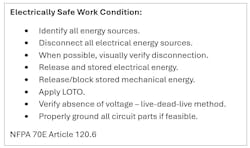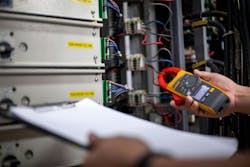The Hidden Hazards of Electrical Maintenance
For electrical contractors, electricians, or technicians performing electrical maintenance activities in various settings, tasks can be divided into two broad categories: planned and unplanned. Planned maintenance includes activities that generally involve preventive and predictive maintenance tasks performed when the equipment can be “planned” to be taken out of service according to a schedule. “Unplanned” maintenance includes scenarios where a piece of equipment has an unexpected failure and requires immediate maintenance to make it operational again. Both categories include various hazards and risks that must be evaluated and mitigated, some of which are more obvious than others. The most powerful tool for protecting workers from hazards is knowledge. Knowing what hazards to watch out for and what tools/techniques are available for their protection helps electrical professionals spot hidden hazards before they strike.
Common hazards with planned maintenance
It is often believed that planned maintenance tasks are inherently safe because there is time to plan the job and consider potential hazards before the activity begins. It certainly is true that taking time to plan the work does increase the level of safety in executing the task, which is why OSHA and NFPA 70E require every electrical task to be planned. That plan should not only outline the steps to be taken, but also identify some of the potential hazards along the way. One of the biggest risks for planned maintenance is the mindset of “this is all de-energized and safe,” which often causes workers to let their guard down. However, de-energizing the equipment is not enough; it must be placed in an electrically safe work condition per NFPA 70E Art. 120 (see Table).
Only when the equipment is in an electrically safe work condition is it considered electrically safe and free from electrical hazards. However, one often overlooked hazard comes during the process of putting it in and out of that electrically safe work condition. Depending on the equipment and the voltage levels, the act of opening and closing the means of disconnect could pose an electrical hazard.
A risk assessment must be performed to determine what electrical personal protective equipment (PPE) is required to operate the disconnect device. Putting the equipment back into service after maintenance can carry even more risk due to potential human error. Devastating equipment failures have occurred as a result of a protective ground being left on a conductor inside an enclosure.
It is a best practice to give all protective grounds a unique number, and — as part of the maintenance procedure — document which ground is placed at which location. Then, at the end of the task, document each ground as it is removed and compare to the initial list to make sure all grounds that were installed are documented as being removed. In addition, if a ground is placed inside of a closed compartment, put a magnetic sign or flag on that compartment as a visual reminder that a ground is installed inside the compartment.
Another aspect of establishing an electrically safe work condition that involves a potential electrical safety risk is verifying the absence of voltage. Since the equipment is in the process of being placed into an electrically safe work condition (but the process is not complete), the equipment and conductors are still to be treated as energized. During the process of verifying the absence of voltage for any circuit rated 50V or greater, voltage-rated gloves and protectors must be worn as a minimum. Depending on the voltage level and incident energy levels, arc flash PPE may also be needed while performing the live-dead-live method to verify the absence of voltage.
The live-dead-live method is the process of using a properly rated digital voltmeter to check all phases and ground to verify the absence of voltage. Ideally, the meter is used to check the voltage on a known energized source of the same nominal voltage to verify that the meter works. Then, without making any changes to the meter, check all phases and ground for all the circuits involved in the maintenance task to confirm the absence of voltage. Then, go back to the known energized source to confirm that the meter is still working. The live-dead-live method eliminates the risk of a meter failure or operational error by including steps to confirm the functionality of the meter.
Another risk to consider and evaluate is the potential hazards associated with what is in the proximity of where the maintenance task is being performed. Too often, workers get narrowly focused on only the specific equipment that is being worked on and overlook hazards in the surrounding area. Workers must do a risk assessment on the area and consider all hazards to which they may be exposed. They must verify that they will not be working within the limited or restricted approach boundaries of any other exposed energized conductors or take appropriate mitigation steps if they are inside one of those boundaries. A large enclosure may contain two systems: one that is in an electrically safe work condition for maintenance and one that is still operational. Often, there is other electrical equipment adjacent to the work area that remain energized. If there is “look-alike” equipment in the same area, consider using the “tape in” and “tape out” technique to avoid inadvertently opening the wrong equipment. Place warning tape/signs on the equipment that is still energized to keep workers out, and place barriers or tape to help guide workers to the electrically safe equipment.
Thermography or infrared (IR) inspection is a predictive maintenance activity that continues to become widely used by more organizations. Thermography can reveal developing abnormalities well before they trend to failure, allowing the opportunity to plan a downtime to make a repair and avoid the looming unplanned outage due to equipment failure. For thermography to be effective, the equipment must be energized and ideally heavily loaded. In addition, the thermography camera needs to have a direct line of sight on the conductors or parts needed for inspection, which means the conductors or parts are typically exposed.
Opening and closing enclosures of energized equipment can be a hazardous activity, especially while wearing voltage-rated gloves and arc flash PPE. A better alternative would be to de-energize the equipment, remove the necessary covers, barricade the area, and then re-energize the equipment for the inspection. A best practice would be to mark the area on the enclosure where the components that need to be viewed for inspection and install infrared (IR) windows at those locations. Then future inspections would not require opening the enclosures, but simply viewing the equipment through the IR windows.
Common hazards with unplanned maintenance
Unplanned maintenance can include the same hazards and risks as planned maintenance, but it also has some unique aspects to consider. When an unplanned maintenance task comes up, it is typically associated with an outage of some kind. Something has failed, and someone is without power or some other service that they need. This scenario promotes a sense of urgency to restore the system to normal. Often, the impacted individual is hovering around watching the electrical workers doing what is needed to bring the system back into service, which just adds to the pressure that the electrical workers feel. This pressure can make it tempting to take risks or shortcuts to try to get the issue resolved as quickly as possible. However, it is never worth the risk to put one’s safety in jeopardy over an inconvenience. The best thing to do is to evaluate the situation and start developing a plan and risk assessment before just jumping in and starting to troubleshoot the problem.
Due to this sense of urgency and pressure surrounding the unplanned outage, there is the risk of forgetting to or being tempted to not put the affected system in an electrically safe work condition before starting to work on it. Article 110 of the NFPA 70E requires that electrical conductors and circuit parts equal to or greater than 50V shall be put into an electrically safe work condition unless it is infeasible to perform the task in that state.
Taking voltage or current readings would be an example of something that is infeasible in an electrically safe work condition. Inconvenient is not the same as infeasible. Sometimes, it is necessary to take additional circuits or systems offline and place them in an electrically safe work condition to safely make the repair. This is another time when the pressure is on, and workers tend to get tunnel vision, often focusing on the specific impacted circuit or system. It is best to periodically step back and get a view of the big picture to ensure there are no adjacent hazards that are being overlooked. Hazard elimination is to be the top priority throughout the entire task.
Another aspect of an unplanned outage is not just getting the system back online, but understanding what caused the failure. Will it happen again? Is there an increased risk of catastrophic failure when the system is ready to be brought back online? The root cause needs to be determined and understood to mitigate the risk of a repeat failure. Even if there was no equipment failure, NFPA 70E Sec. 130.8 prohibits the reclosing of circuits after protective device operation unless a qualified person has determined the equipment and circuit can be safely energized. This becomes even more important after a component or system failure. Have a qualified person investigate the failure and perform a root cause analysis to determine the most likely cause for the failure and make sure that the root cause issue has been corrected or mitigated.
All electrical tasks should be properly planned and evaluated through a risk assessment before beginning work — even if the task is an unplanned maintenance activity. Hazards can appear in various shapes and forms, so it is important to always make it a habit to look for them — and , once they are identified, determine how to mitigate them. When you find yourself “in the moment,” take a few minutes to step back, slow down, think things through, and get a renewed view of the complete picture. Hazard elimination needs to always be the priority. For electrical hazards, this comes in the form of establishing an electrically safe work condition for anything that is exposed during the task.
Any opinion expressed in this article is the personal opinion of the author and does not necessarily represent the official position of the NFPA or its Technical Committees.
About the Author

Tommy Northcott
Senior Power Engineer
Northcott earned a BS Degree in Electrical Engineering with an emphasis in Power Systems from Tennessee Technological University. He is a Professional Engineer licensed in the State of Tennessee, a Certified Reliability Leader, and a Certified Maintenance and Reliability Professional and is a current principle member on the NFPA 70B committee (Recommended Practice for Electrical Equipment Maintenance). Tommy has broad experience working with large electric utility systems as a Systems Engineer, Arc Flash Program Manager, Operations and Maintenance Manager, and Reliability Engineering Manager. Tommy has extensive experience in operations and maintenance of electrical equipment, performing arc flash analysis calculations, developing and conducting electrical safety training and developing company electrical safety standards to ensure OSHA and NFPA 70E compliance. Currently, Tommy is a Senior Power Engineer with Jacobs Technology Inc.


